Special Report
Cities Where Hurricanes Would Cause the Most Damage
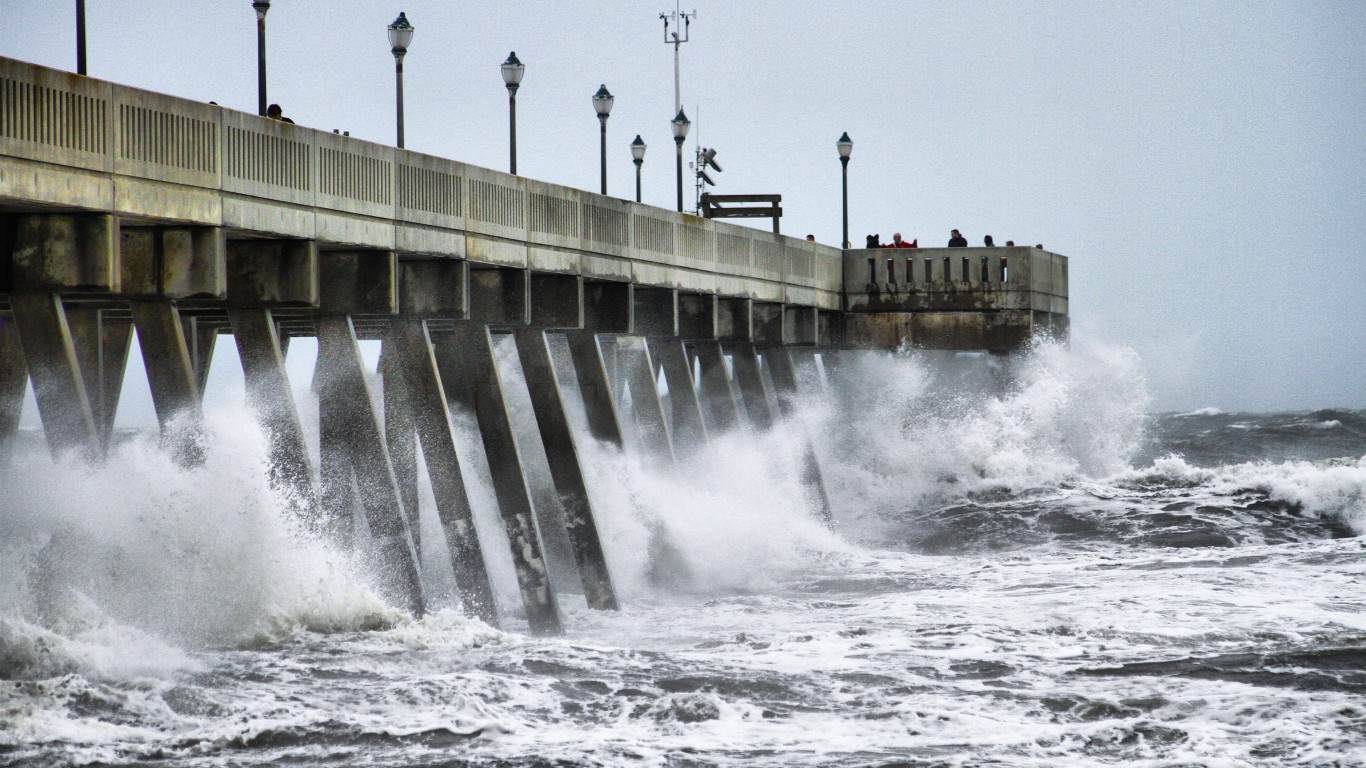
Published:
Last Updated:

Hurricane season can be one of the most nerve-wracking times of the year for Americans living on the coast. The period runs from June 1 to Nov. 30, although severe storms can also occur outside of those dates. While the number of storms that reach U.S. shores varies from year to year — as does their intensity — it only takes one storm to potentially damage hundreds of thousands of homes and cause tens of billions of dollars in damage.
The three elements of a hurricane — wind, precipitation, and storm surge — are also what makes them so wildly destructive. Storm surge, or the water that is pushed on shore by a hurricane, can be particularly destructive. Flooding caused by storm surge is often the most damaging aspect of a hurricane to infrastructure and people’s homes. The extent of such damage can be seen in these before and after pictures of the worst hurricanes in American history.
24/7 Wall St. reviewed the number of homes at risk and the estimated construction costs that would be required to replace these homes should they be damaged for U.S. metro areas along the Atlantic and Gulf coasts from data analytics company CoreLogic. The 15 cities vulnerable to the greatest damage are listed in order of the number of homes at risk of destruction from flooding due to storm surge.
Many of the metropolitan areas where hurricanes would cause the most damage have been hit by recent hurricanes such as last year’s Florence and Michael. Others have been fortunate to avoid seriously damaging storms for a number of years. Charleston, South Carolina, for example, has not seen a major hurricane since Hugo hit in 1989. That storm destroyed 26,000 homes in the region. Should a storm of that magnitude hit Charleston today, far more homes could be destroyed. Some storms have been even more destructive than Hugo. These are the most powerful hurricanes of all time.
The cyclical threat of hurricanes presents itself every year. And as the populations of many of these metro areas grow, and as the coastlines continue to be built and developed, the risk of damage due to storm surge increases.
Click here to see the cities where hurricanes would cause the most damage.
24/7 Wall St. reviewed the number of homes at risk and the estimated construction costs for U.S. metro areas along the Atlantic and Gulf coasts from data analytics company CoreLogic. The 15 cities vulnerable to the greatest damage are listed in order of the number of homes at risk of destruction from flooding due to rainfall and storm surge. Population figures for the surrounding metropolitan areas are as of 2018 and are from the Census Bureau’s American Community Survey (ACS).
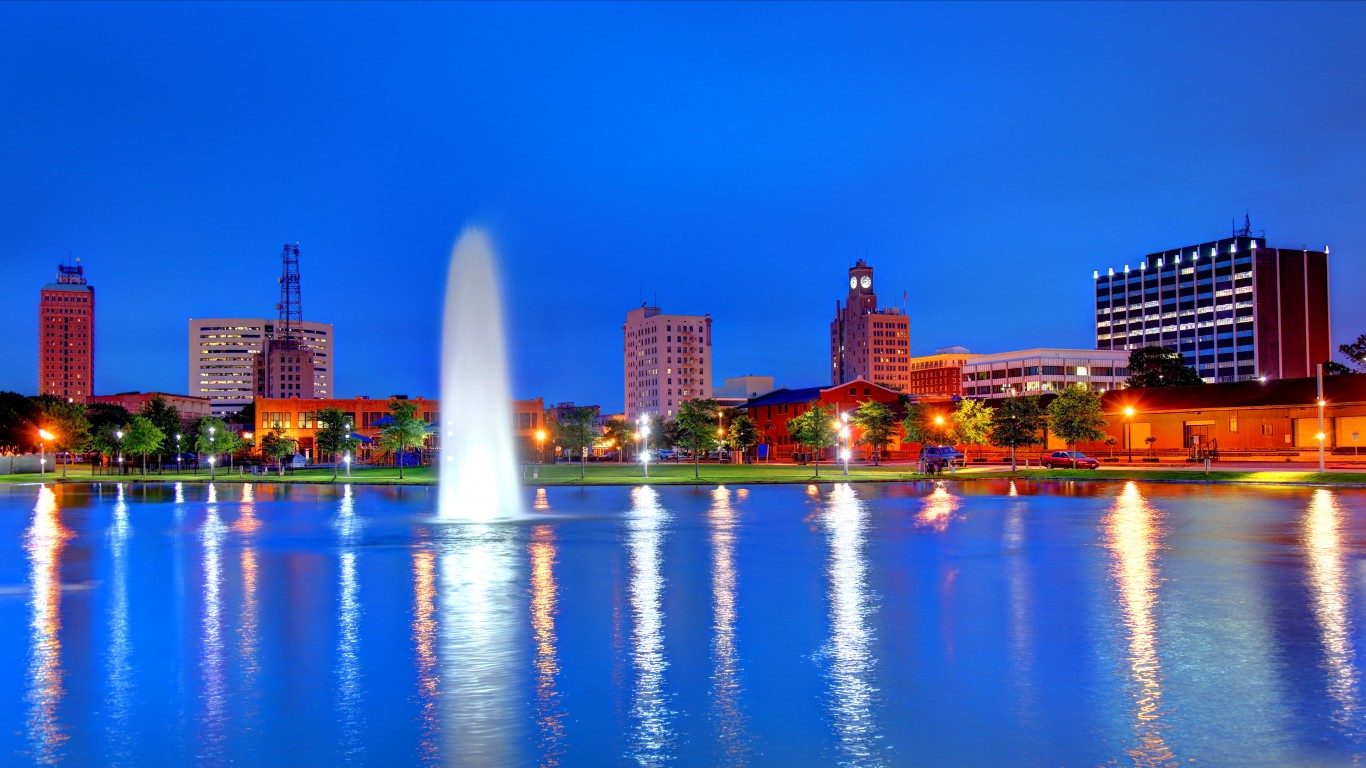
15. Beaumont, TX
> Total properties at risk of hurricane damage: 121,710
> Reconstruction cost value of properties: $22.1 billion
> Metro area population: 409,526
> Recent severe hurricane: Harvey (2017)
Beaumont is located in Southeast Texas, not far from the Louisiana border. Hurricane Harvey hit the city in 2017, effectively turning it into an island due to flooding. Additionally, Beaumont’s municipal water system failed during the ordeal, leaving stranded residents without running water.
[in-text-ad]

14. Boston, MA
> Total properties at risk of hurricane damage: 126,196
> Reconstruction cost value of properties: $34.9 billion
> Metro area population: 4.9 million
> Recent severe hurricane: Bob (1991)
Though Boston may not immediately spring to mind when thinking of hurricanes, the city’s proximity to the Atlantic Ocean and high population density make it especially susceptible to damage from serious storms. In August 1991, Hurricane Bob caused $1.5 billion in damages across New England. The densely populated Boston metro area now has more than 126,000 homes at risk of significant damage from a storm surge.
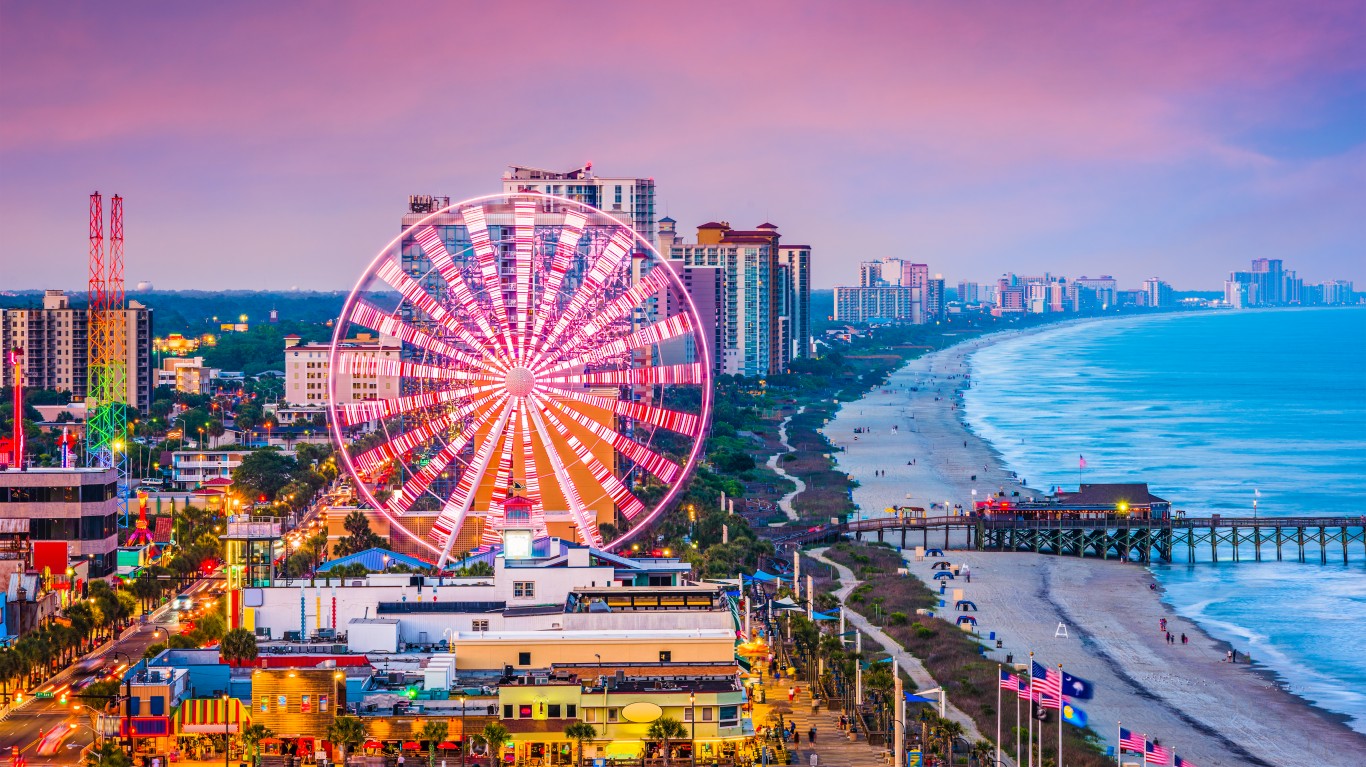
13. Myrtle Beach, SC
> Total properties at risk of hurricane damage: 131,083
> Reconstruction cost value of properties: $24.4 billion
> Metro area population: 480,891
> Recent severe hurricane: Hugo (1989)
With its 60 miles of coastline, South Carolina’s Myrtle Beach is a well-known vacation destination. Its location, however, also makes it vulnerable to dangerous, ocean-borne weather events. Recent hurricanes that have hit the Myrtle Beach area include Matthew in 2016, Charley in 2004, and Floyd in 1999.
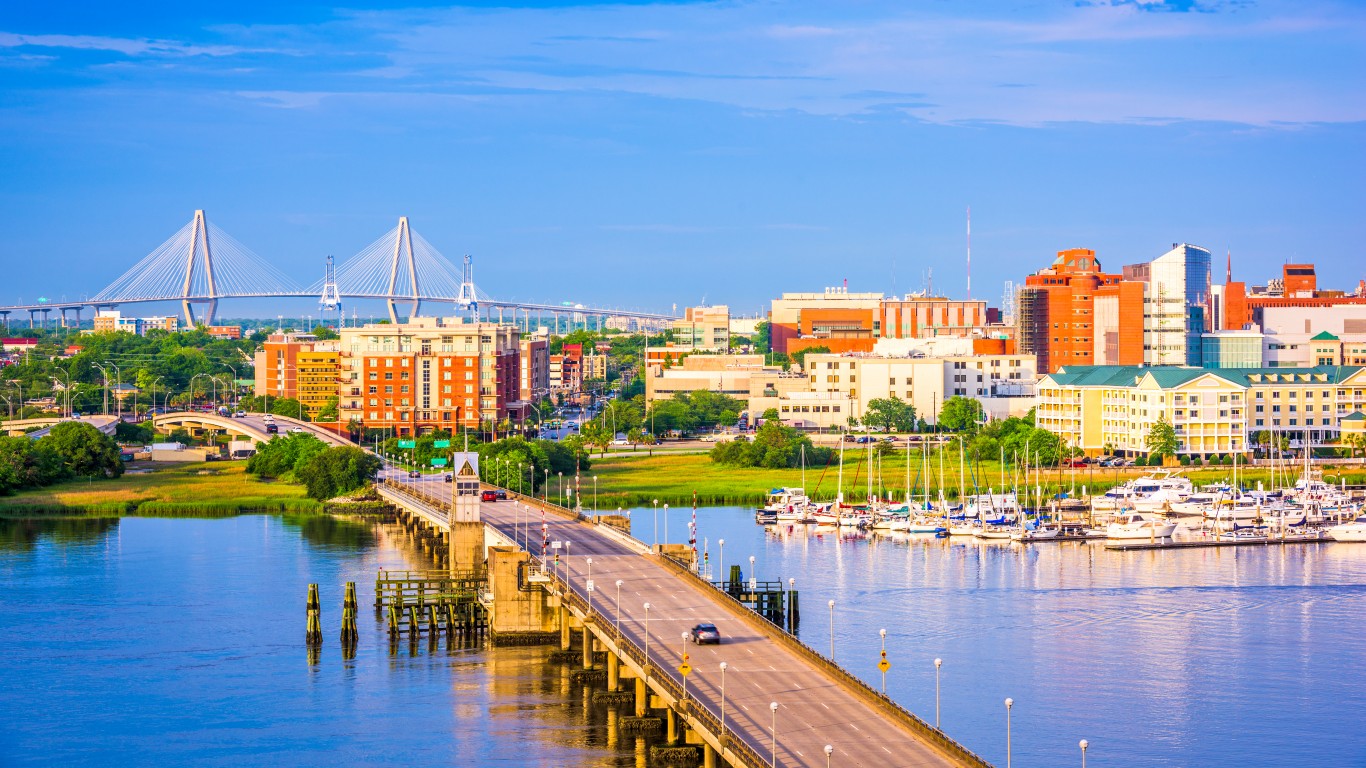
12. Charleston, SC
> Total properties at risk of hurricane damage: 155,740
> Reconstruction cost value of properties: $40.9 billion
> Metro area population: 787,643
> Recent severe hurricane: Hugo (1989)
The Charleston-North Charleston metropolitan area is home to more than 787,000 people, one of the state’s largest urban areas. Many long-term residents of the coastal city know first-hand just how damaging a serious hurricane can be. Hurricane Hugo — the eye of which passed slightly north of Charleston Harbor in 1989 — caused more than $7 billion in total damages and destroyed 26,000 homes across the Carolina Lowcountry.
[in-text-ad-2]
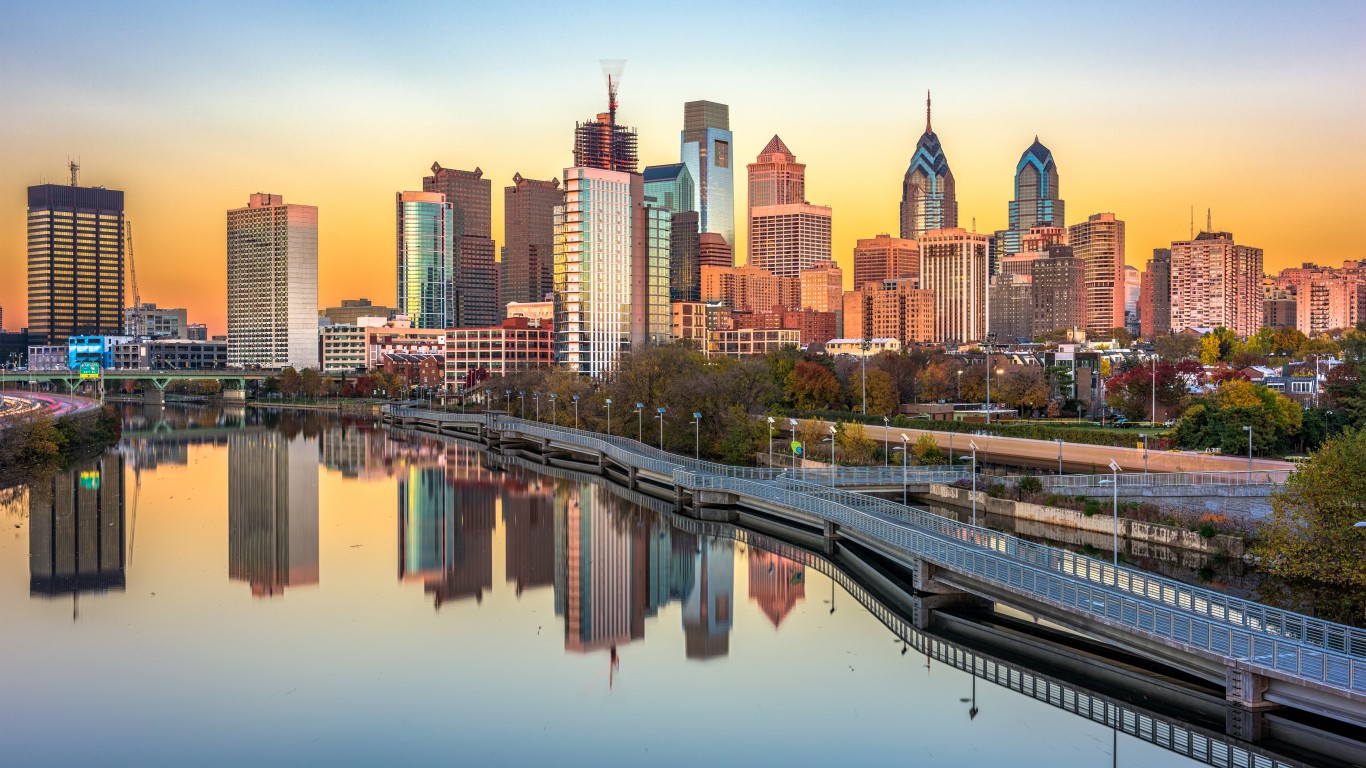
11. Philadelphia, PA
> Total properties at risk of hurricane damage: 166,444
> Reconstruction cost value of properties: $43.3 billion
> Metro area population: 6.1 million
> Recent severe hurricane: Sandy (2012)
Philadelphia is one of the country’s most densely populated cities and, while somewhat protected by New Jersey, is relatively close to the Atlantic. In addition, because of the city’s prominent rivers and tributaries and the advanced age of much of its infrastructure more than 166,000 properties within the metropolitan area are at risk of damage from a hurricane’s storm surge. The estimated reconstruction cost of such damage would be more than $43 billion.

10. Jacksonville, FL
> Total properties at risk of hurricane damage: 176,509
> Reconstruction cost value of properties: $41.1 billion
> Metro area population: 1.5 million
> Recent severe hurricane: Irma (2017)
Located on Florida’s northeast coast, Jacksonville is one of many cities in the state where billions of dollars of property is at risk of storm surge damage from a serious hurricane. Hurricane Irma led to severe flooding in the city in 2017, despite the storm hitting Florida’s Gulf Coast. The storm pushed water from the Atlantic into the St. Johns River, causing floods 4 to 6 feet deep in certain areas.
[in-text-ad]

9. Naples, FL
> Total properties at risk of hurricane damage: 187,205
> Reconstruction cost value of properties: $42.2 billion
> Metro area population: 378,488
> Recent severe hurricane: Irma (2017)
Hurricane Irma left some residents of Naples without water and electricity for days. A powerful storm could indeed be exceedingly damaging in the city, which is located on the southern portion of Florida’s Gulf Coast. With high home values there, the financial damage can be in the tens of billions. According to real estate website Zillow, the city has the highest home values in the state.

8. Bradenton, FL
> Total properties at risk of hurricane damage: 262,745
> Reconstruction cost value of properties: $53.8 billion
> Metro area population: 821,573
> Recent severe hurricane: Hermine (2016)
Bradenton, Florida, which together with Sarasota forms the Sarasota metropolitan area, is located on Florida’s western coast, just south of Tampa Bay. The area managed to avoid major damage during Irma, but more than a quarter-million homes remain at risk of flooding. Bradenton is also susceptible to flooding from the Manatee River, which runs alongside it.
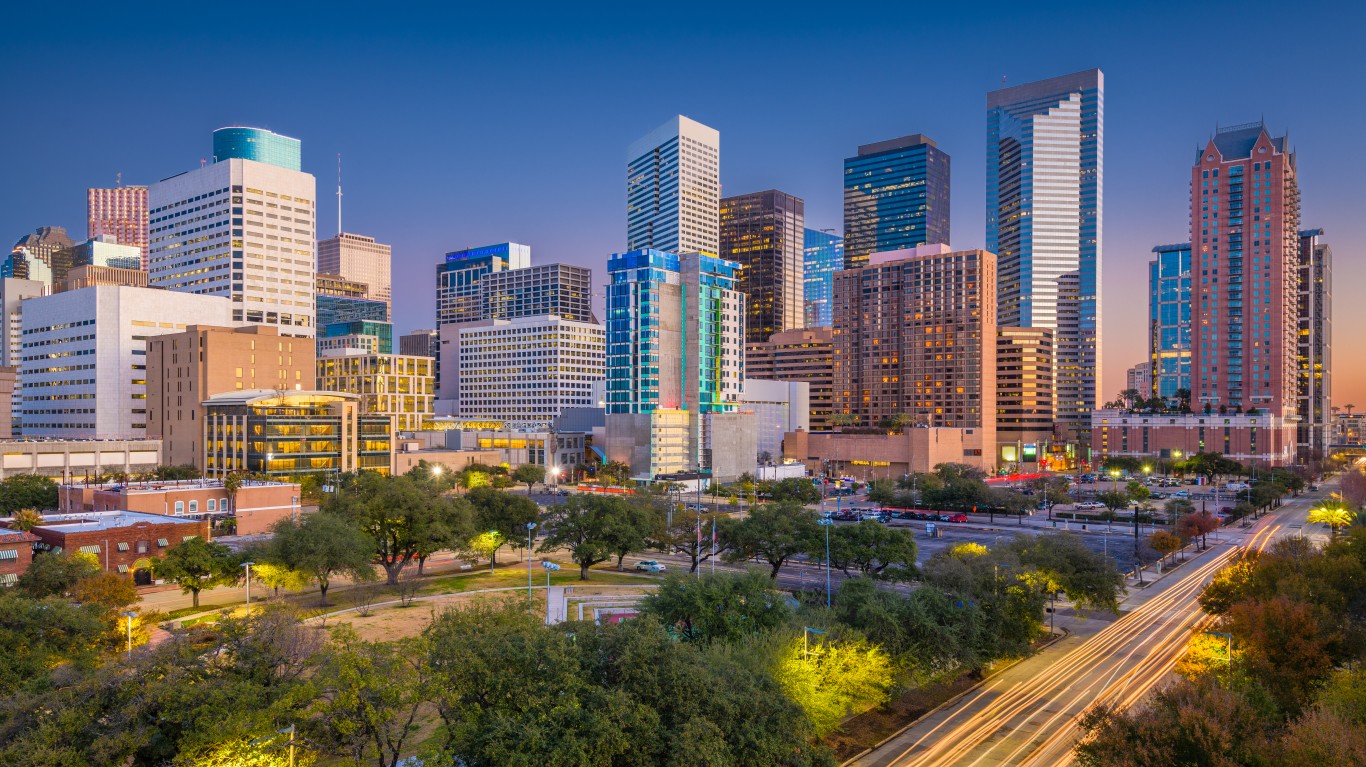
7. Houston, TX
> Total properties at risk of hurricane damage: 294,188
> Reconstruction cost value of properties: $63.8 billion
> Metro area population: 7.0 million
> Recent severe hurricane: Harvey (2017)
The Houston metropolitan area is home to 7 million people. The area’s ongoing urban sprawl is one reason Hurricane Harvey — which is estimated to have caused $125 billion in damages and killed 68 people — was so calamitous. Nearly $64 billion worth of property is at risk of storm surge damage in Houston, the greatest amount in all of Texas.
[in-text-ad-2]

6. Fort Myers, FL
> Total properties at risk of hurricane damage: 329,479
> Reconstruction cost value of properties: $67.6 billion
> Metro area population: 754,610
> Recent severe hurricane: Irma (2017)
Fort Myers is located along the Caloosahatchee River in southwest Florida. It is also a part of the Cape Coral-Fort Myers metro area, which is among the fastest growing areas in the country based on population. During Hurricane Irma, 35,000 people in Fort Myers’ Lee County went to shelters. Currently, nearly 330,000 homes are considered at risk of flooding due to hurricanes.

5. Virginia Beach, VA
> Total properties at risk of hurricane damage: 391,365
> Reconstruction cost value of properties: $94.8 billion
> Metro area population: 1.7 million
> Recent severe hurricane: Matthew (2016)
Virginia Beach and the surrounding Chesapeake Bay area are becoming increasingly predisposed to flooding as land in the area is sinking. Flooding from Hurricane Matthew damaged at least 1,400 homes across the city in 2016. This was due in part to insufficient drainage infrastructure. More than 391,000 properties are now at risk of damage from flooding.
[in-text-ad]
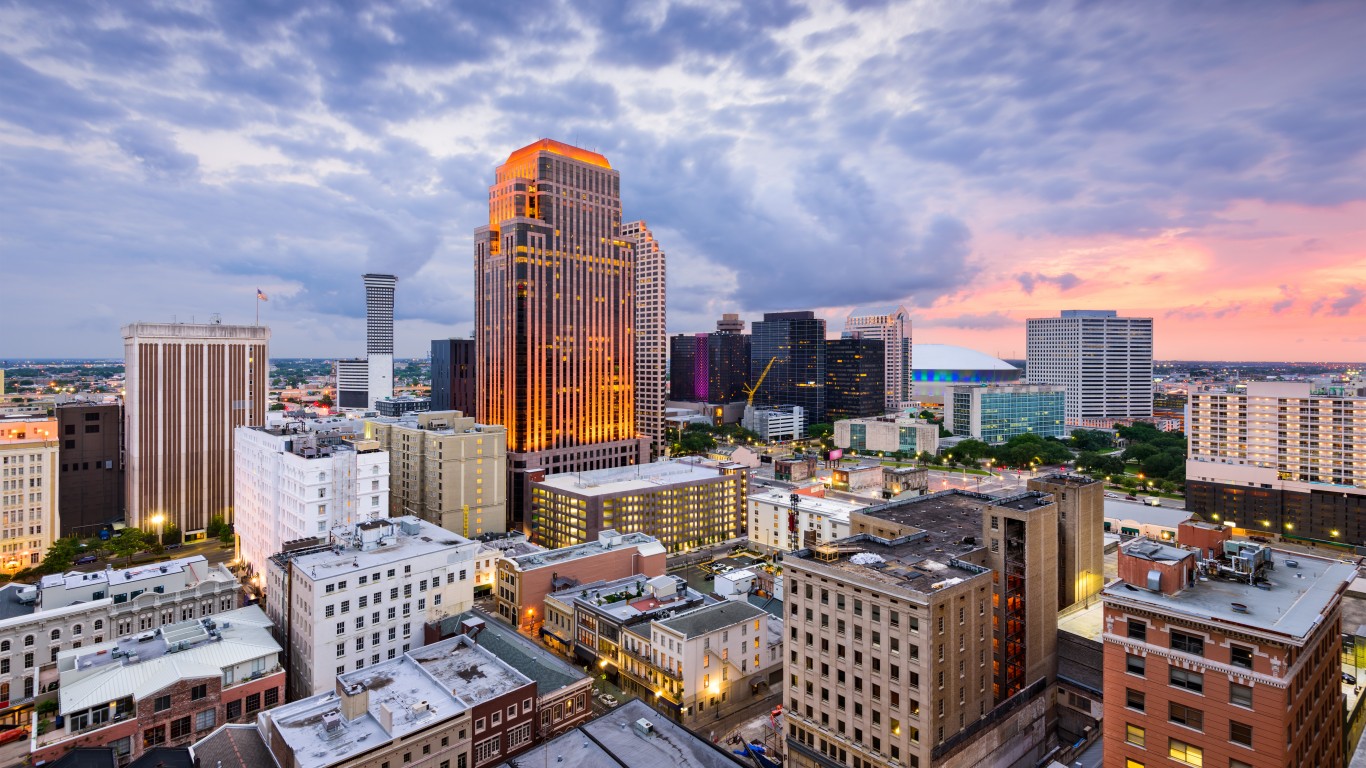
4. New Orleans, LA
> Total properties at risk of hurricane damage: 399,403
> Reconstruction cost value of properties: $100.9 billion
> Metro area population: 1.3 million
> Recent severe hurricane: Katrina (2005)
The tragic events of Hurricane Katrina in 2005 fully demonstrated New Orlean’s vulnerabilities. The city’s flood walls failed to protect it from the Category 3 storm, which contributed to $125 billion in damages and the deaths of 1,577 Louisiana residents. While the city now has some of the nation’s strongest environmental protections, there are still nearly 400,000 properties at risk of flooding due to hurricanes, according to CoreLogic.

3. Tampa, FL
> Total properties at risk of hurricane damage: 465,644
> Reconstruction cost value of properties: $84.1 billion
> Metro area population: 3.1 million
> Recent severe hurricane: Charley (2004)
Tampa is located relatively close to Bradenton on Florida’s Gulf Coast and is likewise exposed to storms entering the Gulf. Many of the city’s residents live near the coast, increasing the risk of property damage from flooding. In 2004, Hurricane Charley caused $16 billion in damages after making landfall as a Category 4 storm just south of Tampa.
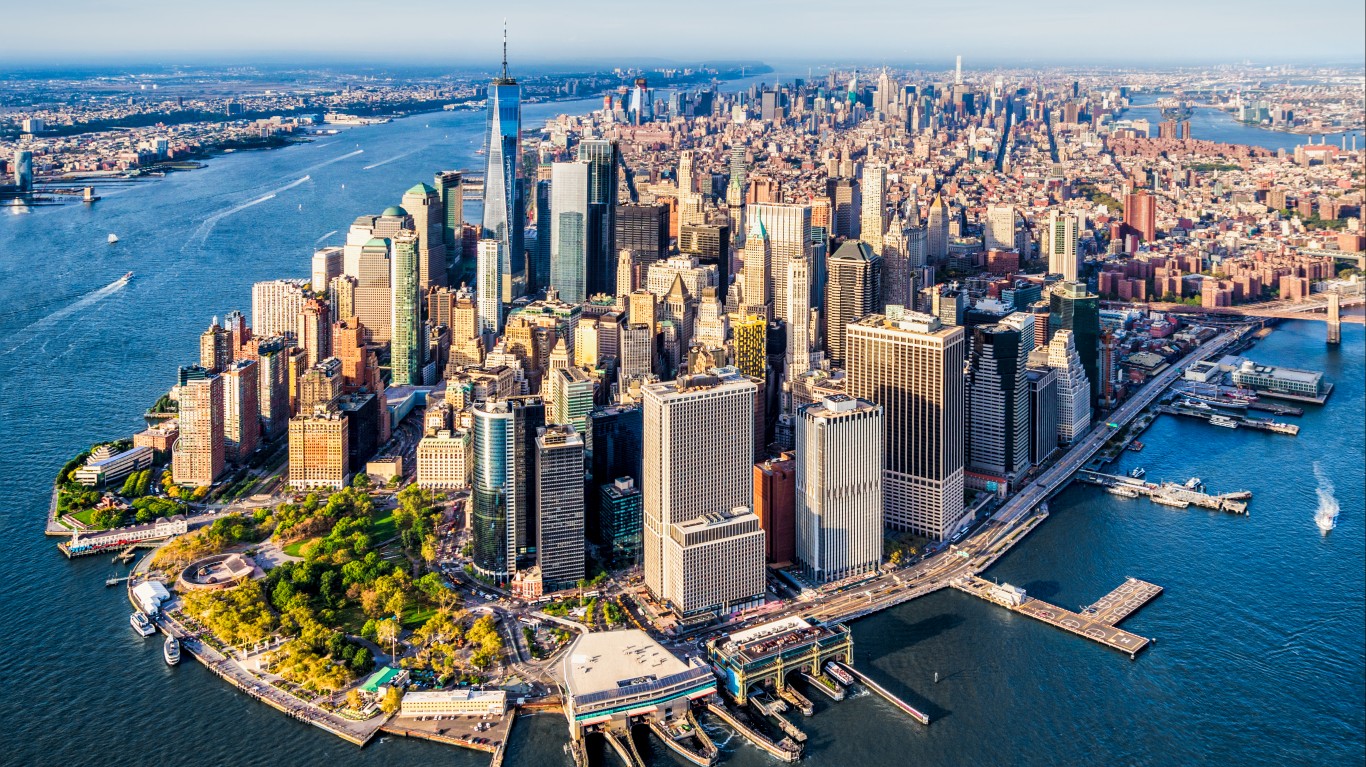
2. New York, NY
> Total properties at risk of hurricane damage: 731,137
> Reconstruction cost value of properties: $283.3 billion
> Metro area population: 20.0 million
> Recent severe hurricane: Superstorm Sandy (2012)
New York City is home to some of the most expensive real estate in the country. It is also, along with the surrounding areas that make up the New York metropolitan area, home to 20 million people — the largest metro area in the country. While New York is less hurricane-prone than a state like Florida, New York City’s coastal properties — combined with the tendency of storms to widen as they move north — make it highly vulnerable to surge risk and damage. According to The National Oceanic and Atmospheric Administration, Superstorm Sandy caused at least $70 billion in damages in 2012.
[in-text-ad-2]
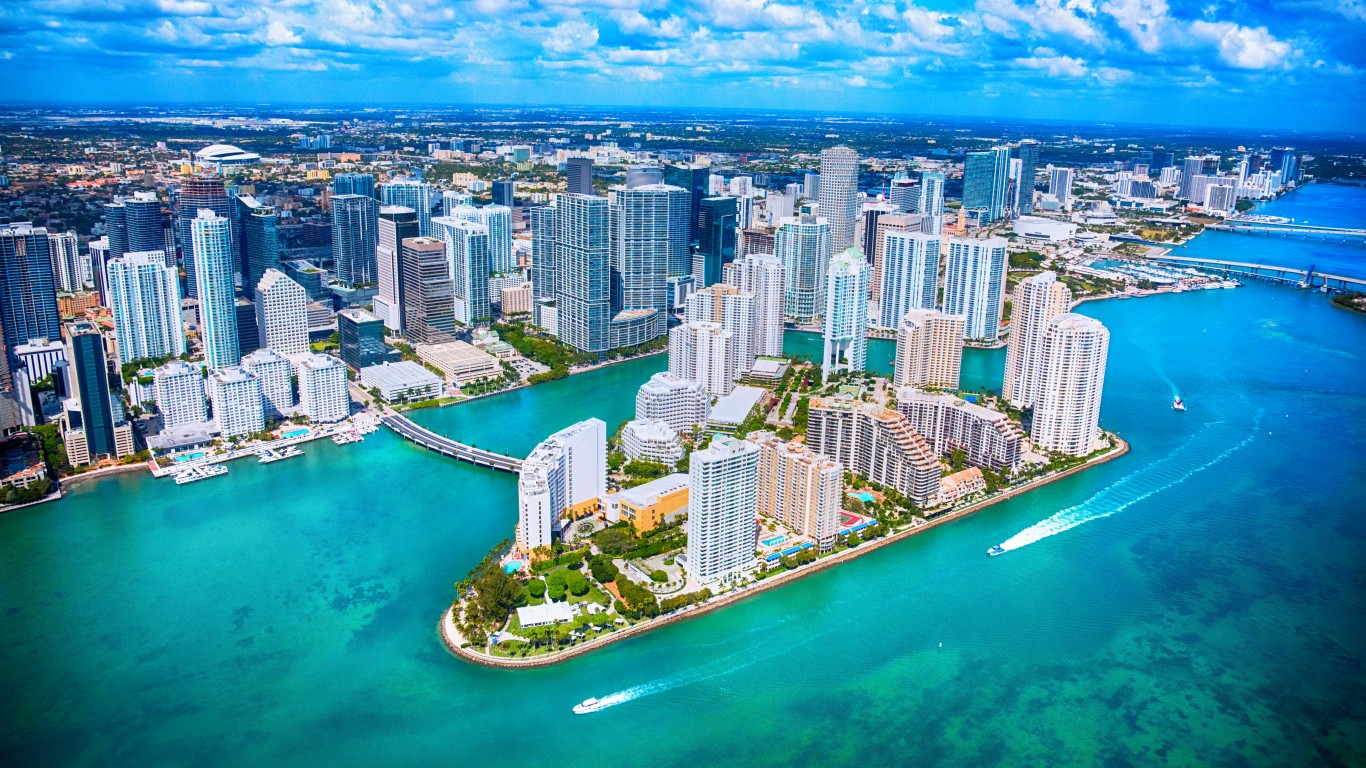
1. Miami, FL
> Total properties at risk of hurricane damage: 791,775
> Reconstruction cost value of properties: $157.7 billion
> Metro area population: 6.2 million
> Recent severe hurricane: Andrew (1992)
Of all U.S. metropolitan areas, Miami has the most homes at risk of flooding from a hurricane, with more than 791,000 vulnerable properties. The area’s risk will continue to increase as its population grows and developers continue to build along its 20 miles of coastline.
Despite its coastal location in Southeast Florida, Miami has avoided a serious encounter with a hurricane for many years. Historically, it has not been so lucky. In August 1992, Hurricane Andrew hit South Florida as a Category 5 storm with wind speeds of 165 miles per hour. There 26 people killed, more than 25,500 homes were destroyed, and over 100,000 additional homes were damaged, while 250,000 people were displaced. The results could be much worse were a similar storm hit the area today.
Credit card companies are pulling out all the stops, with the issuers are offering insane travel rewards and perks.
We’re talking huge sign-up bonuses, points on every purchase, and benefits like lounge access, travel credits, and free hotel nights. For travelers, these rewards can add up to thousands of dollars in flights, upgrades, and luxury experiences every year.
It’s like getting paid to travel — and it’s available to qualified borrowers who know where to look.
We’ve rounded up some of the best travel credit cards on the market. Click here to see the list. Don’t miss these offers — they won’t be this good forever.
Thank you for reading! Have some feedback for us?
Contact the 24/7 Wall St. editorial team.